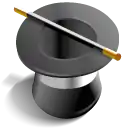Gospel magic
Gospel magic is the use of otherwise standard stage magic tricks and illusions to promote Christian messages.[1] Gospel magic does not claim to invoke spirits or paranormal powers. Gospel magic is intended to present the Christian good news through "visual parables";[2] the trick or illusion is used to present theological points in an entertaining way with the intention that people will remember the message.[3] Gospel magic is generally presented as stage magic or platform magic, but it can be adapted to close-up magic or micromagic situations.
History
The first modern use of Gospel magic is in the ministry of the Italian Catholic priest Giovanni Melchiorre Bosco (Don Bosco, 1815-1888). His autobiography lists many dozens of magic tricks used for the purpose of offering religious instruction to children and youth. Don Bosco has been seen as the Patron Saint of Catholic Magicians and, specifically, Catholic Gospel Magicians.[4]
In 1910, C. H. Woolston published Seeing Truth: Object Lessons with Magical and Mechanical Effects which aimed to help adults working with children in church. Other texts were soon written that incorporated Gospel messages with magic.
In 1953, the International Fellowship of Christian Magicians began in the USA. This rapidly spread the use of the creative arts to teach the Gospel. Many Gospel Performers, dealers and authors made their first attempts at magic under their tuition. There are now chapters in many US and Canadian cities as well as in the UK, Germany and Hong Kong. An International magazine is published The Voice of the FCM every two months. Annual Conventions are held in USA, UK and Germany.[5]
In the Bible
The word "magic" never appears in the Bible. Daniel is called the "chief of the magicians" or "master of the magicians." Daniel 4:9 The Bible condemns sorcery, astrology, speaking to spirits and witchcraft, but never does it condemn "magic."
The arts and ministry
The arts have long been used to present Christian teachings. Icons, parables, music, song, dance, poetry, sculpture, painting, stained glass, theater, radio, film, television, the Internet, stage magic and illusion have all been used. Today this often includes story-telling, drama, puppetry, ventriloquism, balloon-modelling and juggling.
American Gospel magicians
Well-known and influential gospel magicians include Duane Laflin, Dennis Regling,[6] Andre Kole, Scott Wolf, Dock Haley and Brad Brown.
See also
- Silvio Mantelli
- Illusionist
- List of magic tricks
References
- Miller, Jules L. (1976) p.2-3
- Thompson, AD (2001) p9
- Oswald, G and Anderson K. (2007) p. 3
- Magicians Want Don Bosco Declared Their Patron, Zenit News Agency, 29. January 2002.
- "Fellowship of Christian Magicians - Creatively Sharing the Gospel". Fellowship of Christian Magicians. Retrieved Dec 25, 2020.
- Noble, Barnes &. "Amazing Gospel Magic: Bible Lessons With A Magical Appeal|Paperback". Barnes & Noble. Retrieved Dec 25, 2020.
Bibliography
- Miller, Jule L. Spiritual Applications for Tarbell I. Gospel Services. 1976.
- Miller, Jule L. Spiritual Applications for Tarbell II. Gospel Services. 1984.
These books are based on the Tarbell Course, a standard for stage magicians pre-World War II. It was originally intended to be expanded to cover all eight-volumes in the Tarbell Series, but Miller died before this project was completed. This work is slowly being completed by other magicians unofficially.
- Laflin, Duane. Grand Magic Magazine is published monthly electronically and includes Advance (an earlier magazine) with reflections on key Gospel magic topics and two routines. This magazine also has videos of the routines posted on-line to assist learning.
- Thompson, AD Gospel Magic How to use magic Tricks as Visual Aids, Grove Books Limited Cambridge UK 2001
- Oswald, G and Anderson, K. Gospel Patter for Fifty Familiar Effects, 2007
- Dennis Regling's 52 Weeks of Gospel Magic incorporates magical illusions, chemical reactions, balloon twisting and other performance skills to present Christian lessons.
- Stagnaro, Angelo. The Catechist's Magic Kit. Crossroad Publishing. 2009.

